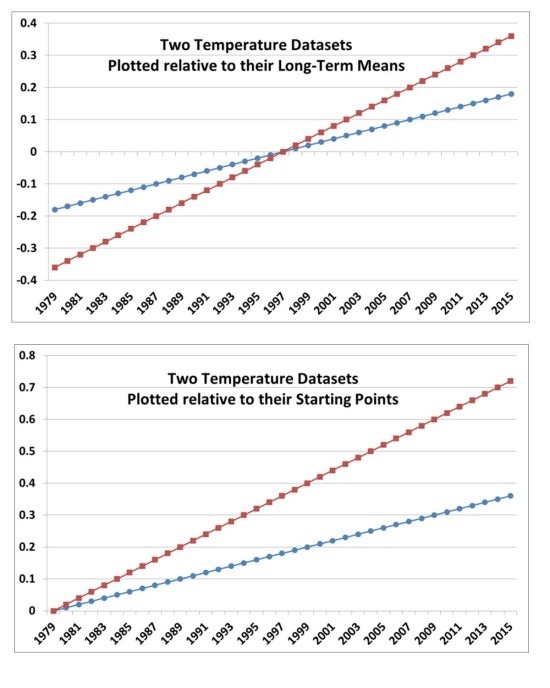Ever since we started posting global temperature comparisons between models and observations there has been a recurring objection over the way the data are plotted. I really thought that the issue would go away because it’s so silly. But I’ve seen it crop up again in the last week in a series of messages between Judy Curry and Gavin Schmidt.
This issue can be summarized with the idealized temperature plots, below. The first plot shows how our critics apparently think two datasets should be plotted for comparison. The second plot is how we think the data should be plotted.
Note that no matter which one you choose, though, both plots show what is important… that the red temperature trace is warming twice as fast as the blue trace.
You might say, “but the disagreement in 2015 between the two traces is only half as big in the first plot as it is in the second plot“.
Yes, but that ignores the fact that there the other half of the disagreement has just been shifted to 1979…nothing has been gained.
It’s really the trends which are important (or, if you don’t like linear trends, pick some other metric of long-term temperature change…none of them is perfect).
We choose to plot the data relative to the same point early in the record. We usually do it relative to the average of the first 5 years of data, so that noise in both datasets has a minimum effect on aligning their starting points.
Or, to avoid that problem entirely, you can compute the trends from each dataset and simply plot all of the linear trend lines with the same starting point.
This is because you start a race at the beginning….not in the middle. How much warming we have seen over a certain period of time (say, since 1979) is relative to the start of that time period…not the middle of the period.
That this issue continues to be a point of contention, quite frankly, astonishes me. All I can think of is that the defenders of the climate models cannot allow any significant criticisms of the models to survive, even when the model shortcomings are staring everyone in the face.

 Home/Blog
Home/Blog




